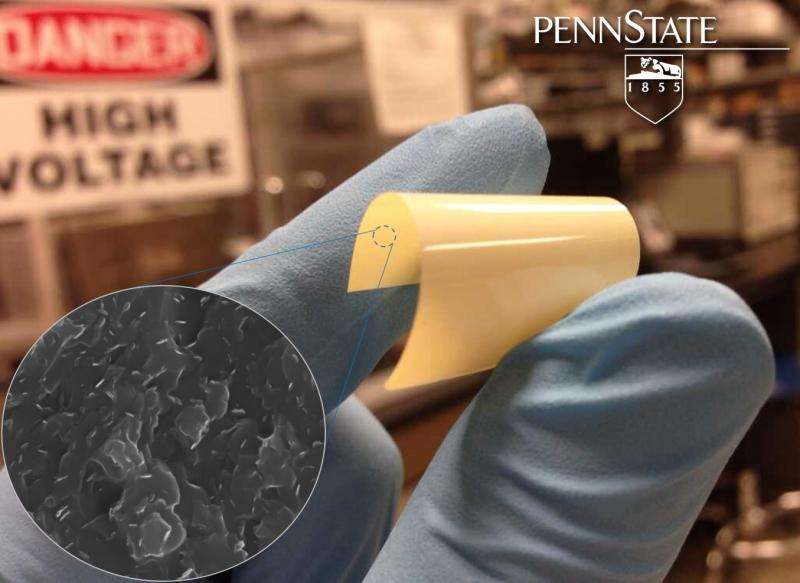July 30, 2015 report
New polymer able to store energy at higher temperatures

(Phys.org)—A team of researchers at the Pennsylvania State University has created a new polymer that is able to store energy at higher temperatures than conventional polymers without breaking down. In their paper published in the journal Nature, the team describes how they created the polymer and why they believe it could be useful in many products. Harry Ploehn with the University of South Carolina offers a brief history of polymers created for use in electronics, in a News & Views piece in the same journal issue, and describes the work done by the team on this new effort—he also offers an opinion on the prospects for the newly development polymer.
As Ploehn notes, dielectric capacitors are used in wide variety of applications that require holding onto a charge and then offering a short burst of power when needed. In many applications dielectrics are made of polymers (because they are light, relatively easy to make and because defects can be easily controlled), but there are still some areas where they cannot be used because they cannot function correctly under temperature extremes—that prevents their use inside car engines, for example. In this new effort, the researchers have taken a new approach to creating a polymer that allows for use in extremely hot applications.
The new polymer was created by the team by adding nanometer-scale sheets of boron nitride to a conventional polymer, which testing showed increased its energy density by 400 percent (which means capacitors made using it could be smaller and thus lighter). And testing also showed the newly improved polymer was able to remain stable at temperatures as high as 300°C, and was able to withstand rigorous bending.
One drawback of the new polymer is that because it requires an extra step, its production costs would be higher than for conventional dielectric polymer capacitors, and there are also still questions about how easy it would be to prevent defects and whether it will stand up to long term wear and tear. If it proves to be resilient and a way can be found to drive down costs, it is likely, Ploehn believes, that the new polymer will have a bright future in applications ranging from hybrid cars to aerospace systems.
More information: Flexible high-temperature dielectric materials from polymer nanocomposites, Nature 523, 576–579 (30 July 2015) DOI: 10.1038/nature14647
Abstract
Dielectric materials, which store energy electrostatically, are ubiquitous in advanced electronics and electric power systems. Compared to their ceramic counterparts, polymer dielectrics have higher breakdown strengths and greater reliability, are scalable, lightweight and can be shaped into intricate configurations, and are therefore an ideal choice for many power electronics, power conditioning, and pulsed power applications. However, polymer dielectrics are limited to relatively low working temperatures, and thus fail to meet the rising demand for electricity under the extreme conditions present in applications such as hybrid and electric vehicles, aerospace power electronics, and underground oil and gas exploration. Here we describe crosslinked polymer nanocomposites that contain boron nitride nanosheets, the dielectric properties of which are stable over a broad temperature and frequency range. The nanocomposites have outstanding high-voltage capacitive energy storage capabilities at record temperatures (a Weibull breakdown strength of 403 megavolts per metre and a discharged energy density of 1.8 joules per cubic centimetre at 250 degrees Celsius). Their electrical conduction is several orders of magnitude lower than that of existing polymers and their high operating temperatures are attributed to greatly improved thermal conductivity, owing to the presence of the boron nitride nanosheets, which improve heat dissipation compared to pristine polymers (which are inherently susceptible to thermal runaway). Moreover, the polymer nanocomposites are lightweight, photopatternable and mechanically flexible, and have been demonstrated to preserve excellent dielectric and capacitive performance after intensive bending cycles. These findings enable broader applications of organic materials in high-temperature electronics and energy storage devices.
Journal information: Nature
© 2015 Phys.org



















